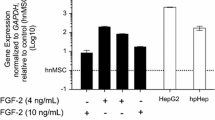Abstract
In vitro disease modeling using pluripotent stem cells can be a fast track screening tool for toxicological testing of candidate drug molecules. Dimethyl sulfoxide (DMSO) is one of the most commonly used solvents in drug screening. In the present investigation, we exposed 14- to 21-day-old embryoid bodies (EBs) to three different concentrations of DMSO [0.01% (low dose), 0.1% (medium dose) and 1.0% (high dose)] to identify the safest dose that could effectively be used as solvent. We found that DMSO treatment substantially altered the morphology and attachment of cells in concurrence with a significant reduction in cell viability in a dose-dependent manner. Gene expression studies revealed a selective downregulation of key markers associated with stemness (Oct-4, Sox-2, Nanog and Rex-1); ectoderm (Nestin, TuJ1, NEFH and Keratin-15); mesoderm (HAND-1, MEF-2C, GATA-4 and cardiac-actin); and endoderm (SOX-17, HNF-3β, GATA-6 and albumin), indicating an aberrant and untimely differentiation trajectory. Furthermore, immunocytochemistry, flow cytometry and histological analyses demonstrated substantial decrease in the levels of albumin and CK-18 proteins coupled with a massive reduction in the number of cells positive for PAS staining, implicating reduced deposits of glycogen. Our study advocates for the first time that DMSO exposure not only affects the phenotypic characteristics but also induces significant alteration in gene expression, protein content and functionality of the differentiated hepatic cells. Overall, our experiments warrant that hESC-based assays can provide timely alerts about the outcome of widespread applications of DMSO as drug solvent, cryoprotectant and differentiating agent.




Similar content being viewed by others
References
Adler S, Lindqvist J, Uddenberg K, Hyllner J, Strehl R (2008) Testing potential developmental toxicants with a cytotoxicity assay based on human embryonic stem cells. Altern Lab Anim 36(2):129–140
Bakar B, Kose EA, Sonal S, Alhan A, Kilinc K, Keskil IS (2011) Evaluation of the neurotoxicity of DMSO infused into the carotid artery of rat. Injury (epub ahead of print, Sep 8 2011)
Carpenter MK, Frey-Vasconcells J, Rao MS (2009) Developing safe therapies from human pluripotent stem cells. Nat Biotechnol 27(7):606–613
Chen TH, Wang YH, Wu YH (2011) Developmental exposures to ethanol or dimethylsulfoxide at low concentrations alter locomotor activity in larval zebra fish: implications for behavioral toxicity bioassays. Aquat Toxicol 102(3–4):162–166
Darling D, Tavassoli M, Linskens MH, Farzaneh F (1989) DMSO induced modulation of c-myc steady-state RNA levels in a variety of different cell lines. Oncogene 4(2):175–179
Inamdar MS, Venu P, Srinivas MS, Rao K, VijayRaghavan K (2009) Derivation and characterization of two sibling human embryonic stem cell lines from discarded grade III embryos. Stem Cells Dev 18(3):423–433
Jasmin, Spray DC, Campos de Carvalho AC, Mendez-Otero R (2010) Chemical induction of cardiac differentiation in P19 embryonal carcinoma stem cells. Stem Cells Dev 19(3):403–411
Liu J, Yoshikawa H, Nakajima Y, Tasaka K (2001) Involvement of mitochondrial permeability transition and caspase-9 activation in dimethyl sulfoxide-induced apoptosis of EL-4lymphoma cells. Int Immunopharmacol 1(1):63–74
Mamidi MK, Pal R, Bhonde R, Zakaria Z, Totey S (2010) Application of multiplex PCR for characterization of human embryonic stem cells (hESCs) and its differentiated progenies. J Biomol Screen 15(6):630–643
Marks PA, Breslow R (2007) Dimethyl sulfoxide to vorinostat: development of this histone deacetylase inhibitor as an anticancer drug. Nat Biotechnol 25(1):84–90
Miller DR, Allison DP, Rorvik MC, Slaga TJ (1991) Inhibited morphological terminal differentiation and enhanced proliferation of cultured mouse epidermal cells at different concentrations of dimethyl sulphoxide. Cell Prolif 24(2):191–201
Nirogi R, Kandikere V, Bhyrapuneni G, Ponnamaneni RK, Palacharla RC, Manoharan AK (2011) Effect of dimethyl sulfoxide on in vitro cytochrome P450 1A2 mediated phenacetin-o-deethylation in human liver microsomes. Drug Metab Dispos (epub ahead of print, Aug 8 2011)
Omary MB, de Grandpre L, McCaffrey M, Kagnoff MF (1992) Biochemical and morphological differentiation of the human colonic epithelial cell line SW620 in the presence of dimethylsulfoxide. J Cell Biochem 48(3):316–323
Pal R, Totey S, Mamidi MK, Bhat VS, Totey S (2009) Propensity of human embryonic stem cell lines during early stage of lineage specification controls their terminal differentiation into mature cell types. Exp Biol Med (Maywood) 234(10):1230–1243
Pal R, Mamidi MK, Das AK, Bhonde R (2011) Human embryonic stem cell proliferation and differentiation as criteria to evaluate developmental toxicity. J Cell Physiol 226(6):1583–1595
Santos NC, Figueira-Coelho J, Martins-Silva J, Saldanha C (2003) Multidisciplinary utilization of dimethyl sulfoxide: pharmacological, cellular, and molecular aspects. Biochem Pharmacol 65(7):1035–1041
Seya K, Kanemaru K, Matsuki M, Hongo K, Kitahara H, Kikuchi H, Oshima Y, Kubohara Y, Okumura K, Motomura S, Furukawa KI (2011) Br-DIF-1 accelerates 1% dimethyl sulfoxide-induced cardiomyocyte differentiation from P19CL6 embryonic carcinoma cells. Br J Pharmacol (epub ahead of print, Jun 15 2011)
Srinivas S, Sironmani TA, Shanmugam G (1991) Dimethyl sulfoxide inhibits the expression of early growth-response genes and arrests fibroblasts at quiescence. Exp Cell Res 196(2):279–286
Thomson JA, Itskovitz-Eldor J, Shapiro SS, Waknitz MA, Swiergiel JJ, Marshall VS, Jones JM (1998) Embryonic stem cell lines derived from human blastocysts. Science 282(5391):1145–1147
Wang Y, Chen G, Song T, Mao G, Bai H (2010) Enhancement of cardiomyocyte differentiation from human embryonic stem cells. Sci China Life Sci 53(5):581–589
Acknowledgments
The work was supported by Stempeutics Research Malaysia. The authors are grateful to Ms Saratha Devi Thrichelvam for technical help in flow cytometry.
Conflict of interest
Authors declare no conflict of interest.
Author information
Authors and Affiliations
Corresponding authors
Rights and permissions
About this article
Cite this article
Pal, R., Mamidi, M.K., Das, A.K. et al. Diverse effects of dimethyl sulfoxide (DMSO) on the differentiation potential of human embryonic stem cells. Arch Toxicol 86, 651–661 (2012). https://doi.org/10.1007/s00204-011-0782-2
Received:
Accepted:
Published:
Issue Date:
DOI: https://doi.org/10.1007/s00204-011-0782-2




